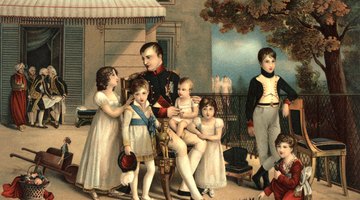France was a troubled country during the 19th century as a result of its inability to settle on a stable political system after the Napoleonic Empire. Royalists, Republicans and Bonapartists remained in conflict with one another throughout the century, leading to several abrupt shifts between monarchical, imperial and republican forms of government before 1900. Following the French Revolution, when the nation’s lower classes overthrew the longstanding Bourbon monarchy, the country established its First Republic in 1792. The new Republic was shortly afterwards overthrown by Napoleon Bonaparte in 1799, whose imperial government would fall in 1815. France continued to shift back and forth between republican and imperial governments until the establishment of the Third French Republic, which would stand until 1940.
Napoleonic Era and Restoration of Monarchy
Napoleon Bonaparte was crowned Emperor of France in 1804, 11 years after King Louis XVI was publicly beheaded by his subjects. Bonaparte, who led a string of military victories for the French Army during the First Republic, became the head of the French government as consul for life in 1802, and then emperor two years later. After Bonaparte’s abdication and exile in 1815, the monarchy was reestablished under the rule of Louis XVIII, nephew of Louis VXI, until his death in 1824. The Bourbon family’s rule of France would end with Charles X during the July Revolution of 1830.
Second Republic 1848-1852
The Second French Republic was established after the Revolution of 1848 led to the abdication of King Louis-Philippe, a cousin of the Bourbon family. That year Louis Napoleon – who would become Napoleon III – was elected president of the constitutional French Republic. In a move to gain power over the country’s legislative assembly, Louis-Napoleon organized a coup in 1851 that resulted in a new constitution that reduced the power of the assembly. Louis-Napoleon was proclaimed emperor in 1852, ushering in the Second Empire.
Second Empire 1852-1870
Although Napoleon III’s rule during France’s Second Empire was initially authoritarian, he gradually introduced liberal reforms -- such as freedom of assembly and liberty of the press – in the 1860s. However, these liberalizations allowed the French people to legally voice their political grievances, leading to mass demonstrations against the empire. Although a new constitution establishing a semi-parliamentary government was approved in 1870, France’s defeat in the Franco-Prussian War that year was followed by large-scale uprisings in Paris that ultimately resulted in the collapse of the imperial government and abdication of Napoleon III.
Third Republic 1870-1940
Although the Third Republic of France was ushered in by the fall of Napoleon III in 1870, the Musee d’Orsay reports the republic did not truly begin until 1875. That year, the passage of the Wallon amendment described France as a “Republic.” The amendment also established that the president of the Republic be elected by an absolute majority of votes in the National Assembly and may serve seven-year terms with the opportunity for re-election. The Third Republic remained intact until Nazi Germany conquered France in 1940.
Related Articles
References
Writer Bio
Ashley Portero has been covering state and national politics since 2011. Her work has appeared in "The Boston Globe," "The Boston Business Journal" and the "International Business Times." She received a Bachelor of Science degree in journalism from Emerson College.











